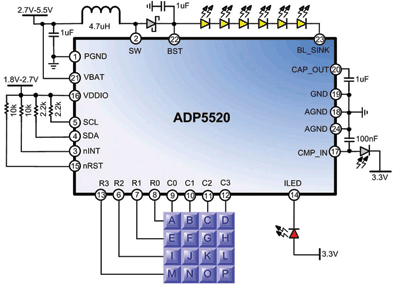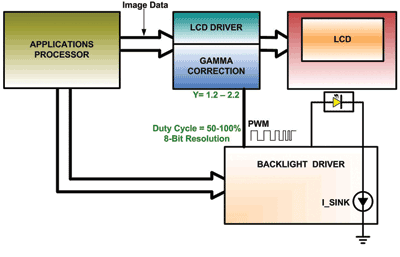Power reduction for media-rich mobile devices
Manufacturers must develop innovative ways to reduce power consumption or increase battery capacity
BY ANTONY CHRISTIAN
Analog Devices, Norwood, MA
http://www.analog.com
The demand for mobile devices with high-end features is rapidly increasing. Features like text messaging, gaming, GPS navigation, Web browsing and video playback on high-resolution color displays are becoming the norm in today’s portable consumer electronics market. While consumers are asking for these high-end features, they also want reasonable battery life. Unfortunately, the larger high-resolution displays are backlight and processor intensive, which translates to longer and larger drain on the already limited battery capacity.
Despite recent advances in battery technology, battery capacity has not evolved fast enough to keep up with the extra energy demands of multimedia devices. Since battery technology has not improved at the same pace as battery usage, device manufacturers have encountered difficulties with meeting consumer expectations. Unless they develop innovative ways to reduce power consumption or increase battery capacity, the system will need to sacrifice battery run time for features.
The display backlight has become a major battery drain for most portable device manufacturers. Media intensive devices with high-resolution color displays require proper backlighting at all time to avoid degrading optical performance and readability.
In addition to techniques such as time based dimming, display timeouts, and user selectable brightness settings, many device manufacturers are implementing ambient light sensing (ALS), and content adaptive backlight control (cABC) to improve system efficiency by reducing current drain.
While devices save power by dimming the backlight during times of inactivity, many applications, such as Web browsing, e-mails, GPS navigation, gaming, or video playback require the backlight to remain on during long periods of user interaction.
The brightness control in the products settings menu allows the user to adjust the backlight intensity to save power during these use cases, but requires user input and needs multiple changes for different ambient light conditions to really be effective. These techniques are no longer practical, nor sufficient to meet today’s intensive and unique use cases.
Ambient light sensing
The amount of backlight required by an LCD or keypad varies with changes in the lighting environment. With ambient light sensing (ALS), a photo diode or transistor measures the local light intensity and translates it into current or voltage. Based on preset thresholds, the backlight driver or processor can determine how much backlight is required.
The high current required during sunny conditions wastes energy during dim light conditions, and can cause eye strain in dark conditions. Changing backlight intensity based on ambient light can save more than 60% of the current necessary to drive the backlight in bright conditions for typical use cases.
ALS implementation methods
Analog or digital light sensors can be used to measure the ambient light. Regardless of which sensor is used, the output needs to be decoded in order to be useful. Many designs use the host processor to decode the sensor output and control the backlight. However, the host processor must be fast enough to provide multimedia features, so its higher speed and bandwidth also means higher current drain for ALS polling functions. Minimizing processor involvement is essential to keep down battery consumption.
Some ICs integrate light input decoding and backlight driver control. Integrating the light sensor intelligence in the backlight driver has several advantages. First, the driver uses a simple state machine, reducing the current required for decoding and backlight control to less than 20 μA. Second, everything is in one package, thus minimizing the number of connections and traces in the PCB layout. Third, it minimizes back and forth communication between the backlight driver and the host processor.
Because all mechanical designs are different, it is essential that the intelligent driver have enough flexibility to handle all conditions. To provide the required flexibility, these integrated devices have implemented programmable threshold, hysteresis and filter time, making it easy for handset manufacturers to correct for product to product variances.

Fig. 1. Series backlight driver with integrated photo-sensor input, and mini keypad/GPIO expander
Display backlight analysis
A display backlight using six series LEDs driven at 18 mA draws 111 mA from the battery (assuming 3.5-V LED forward voltage, 85% driver efficiency, and a 4-V battery). So, the display backlight alone can drain a 1,100-mAh battery in 9.9 hours if driven at maximum intensity all of the time. The display does not have to be illuminated at maximum backlight intensity under all conditions, allowing significant power to be saved in lower light environments, such as offices, movie theaters, and outdoors at night.
Sunny day luminance can vary from 32,000 to 100,000 lux, two orders of magnitude greater than a 400-lux brightly lit office, so cutting the backlight intensity by half, or even more, when going from outside to inside will not cause any loss of display readability. Most people spend an average of 60% of their time indoors, so lowering the backlight brightness can reduce current drain by approximately 50% or more. Using ALS, The backlight current in the previous example will go from 111 mA to 55.5 mA and will last 19.8 hours on a 1,100-mAh battery.
Content adaptive backlight control (cABC)
As shown in Fig. 2, cABC is a method that analyzes display content and adjusts the display backlight based on the grayscale content of the image and gamma correction techniques. The display driver outputs a PWM waveform to the backlight driver, with varying duty cycle based on video grayscale content and gamma correction. Backlight brightness is reduced for dark images, in turn reduces backlight power consumption and enhances display contrast while maintaining vivid display quality. This method is particularly useful in video playback where scenes can change from bright to dark for extended time periods. cABC can also reduce current drain for still images and standard menu screens.
The user interface on the mobile product can be tailored to take advantage of these savings. Depending on image data, cABC can reduce display power by 20% to 50%. When combined with ALS, power saving can exceed 70%. Backlight driver ICs, like Analog Devices’ ADP8870, are already taking advantage of the combined power saving of ALS and cABC. Table 1 illustrates power savings with ALS in different lighting environments.

Table 1. ALS impact on backlight current drain in different light environment

Fig. 2. Content adaptive backlight control (cABC)
Keypad backlight
In addition to display backlight, ALS can also save power on keypad backlight. Most keypads have a visible silkscreen, so no backlighting is required when ambient light is available. An average size keypad backlight draws about 30 mA from the battery. Without ALS, the keypad must be backlit at all times, wasting a lot of energy. With ALS, the backlight driver can turn off or dim the keypad backlight, saving hundreds of mAh. Backlight drivers with integrated ALS control provide interrupt notifications between light changes, allowing the processor to make changes in keypad or other peripheral lighting.
Demands for larger, higher-resolution color displays will continue to rise in the years to come. Devices equipped with cABC, ALS and other current saving techniques are allowing consumers to watch videos, browse the Web and send text messages with vivid display quality, all while keeping backlight power consumption in check. Continuing to find ways to curtail backlight power consumption will be a challenge, but new methods are being developed to address the high power consumption of displays and processors. Using ALS, cABC, and other innovative power reduction techniques will enable manufacturers to provide the media rich devices craved by today’s consumers without compromising multimedia features or extended battery life. ■
Advertisement
Learn more about Analog Devices





